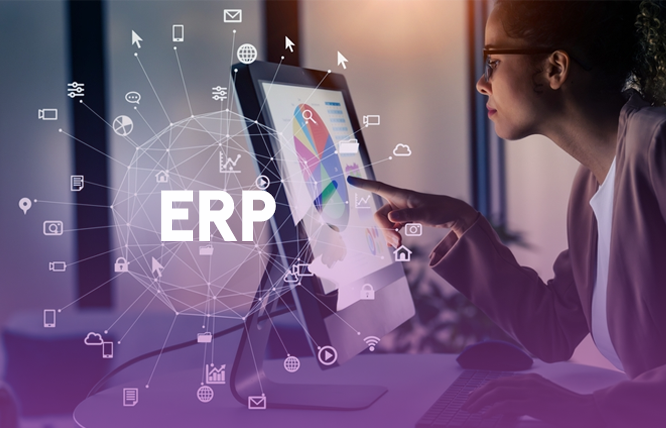Introduction
An ERP system can work wonders for any size business and while the cost may be daunting, the benefits they provide in the long term are enough to push your company to success. In this article, we will discuss the cost-benefit analysis of integrating an ERP system to your business.
Enterprise Resource Planning (ERP) systems have become an essential tool for businesses of all sizes, including small enterprises. These systems integrate various business processes and functions into a single unified system, providing a holistic view of operations. For small businesses, investing in an ERP system can be a significant decision.
Following ERP implementation, nearly half (49%) of companies reported witnessing enhancements across their business processes. This shows that ERP systems can be beneficial for organisations of all sizes.
In this article we will provide a detailed cost-benefit analysis to help small business owners understand the potential return on investment (ROI) from implementing an ERP system.
Understanding ERP Systems
ERP systems are software platforms that centralise and streamline business processes across different departments, such as finance, human resources, supply chain, and customer relations. Key components typically include modules for accounting, inventory management, order processing, customer relationship management (CRM), and human resource management (HRM). Popular ERP systems for small businesses include SAP Business One, Oracle NetSuite, and Microsoft Dynamics 365.
Costs of Implementing an ERP System
There are several different factors that impact the cost of implementing an ERP system to your business. These can range from fixed costs to variable costs, and it is important to keep all of these in consideration.
Initial Costs
- Software Purchase or Subscription Fees: This is the upfront cost for acquiring the ERP software. Businesses can either purchase the software, which involves a one-time payment or opt for a subscription-based model, where payments are made on a monthly or annual basis. Subscription-based models often reduce initial costs but result in recurring expenses.
- Hardware and Infrastructure Costs: Depending on whether the ERP system is cloud-based or on-premises, there may be costs for necessary hardware and infrastructure upgrades. On-premises systems require servers, network equipment, and possibly additional IT infrastructure, while cloud-based systems primarily incur costs related to cloud service subscriptions.
Implementation Costs
- Consulting Fees: Many small businesses lack the in-house expertise to implement an ERP system, making it necessary to hire consultants. These consultants help with system configuration, data migration, and overall project management, ensuring the ERP system meets the needs of the business.
- Customisation and Configuration Costs: Most ERP systems need to be customised to fit the processes and requirements of the business. Customisation might involve developing specific modules, integrating with other existing systems, and configuring the software to align with business workflows.
- Data Migration Expenses: Migrating existing data from legacy systems to the new ERP system is a critical step that can incur substantial costs. This process includes data extraction, cleansing, transformation, and loading into the new system.
Training Costs
- Staff Training Programs: For an ERP system to be effective, employees must be proficient in using it. This requires investing in comprehensive training programs to educate staff on the new system’s functionalities. Training can be conducted through workshops, online courses, or hiring trainers.
- Documentation and User Manuals: Creating detailed user manuals and documentation is necessary to support staff training and ensure smooth adoption of the new system. These materials provide a reference for employees and help reduce the learning curve.
Ongoing Costs
- Maintenance and Support Fees: Regular maintenance and technical support are essential to keep the ERP system running smoothly. These costs cover software updates, troubleshooting, and user support services.
- Update and Upgrade Expenses: ERP systems need to stay current with technological advancements and changing business needs. Periodic updates and upgrades, which may require additional investment, ensure that the system continues to provide optimal performance and security.
- Cloud Hosting or Server Maintenance: For cloud-based ERP systems, ongoing subscription fees are incurred for hosting services. For on-premises systems, costs include maintaining and managing the servers and other related infrastructure.
Benefits of an ERP System for Small Businesses
ERP systems can go a long way when it comes to providing benefits to your business. These benefits are geared towards providing your organisation long term value and increased ROI in the future.
Enhanced Efficiency & Productivity
ERP systems streamline business processes by integrating various functions into a single system, eliminating the need for disparate software solutions. This integration reduces the time and effort required to manage different business activities, such as accounting, inventory management, and human resources. By automating routine tasks and providing a unified view of business operations, ERP systems help small businesses improve efficiency and productivity.
Improved Decision-Making
With an ERP system, small businesses gain access to real-time data and insights across all departments. This centralised data repository enables managers to make informed decisions based on accurate and up-to-date information. Advanced reporting and analytics features allow businesses to identify trends, monitor performance, and forecast future needs, supporting strategic planning and decision-making.
Scalability
ERP systems are designed to grow with the business. As small businesses expand, they can easily add new users, modules, and functionalities to the existing ERP system. This scalability ensures that the ERP system can accommodate increased complexity and volume of operations without requiring a complete overhaul or replacement of the software.
Cost Savings
While the initial investment in an ERP system can be substantial, the long-term cost savings are significant. By automating manual processes and reducing errors, ERP systems help small businesses save time and reduce labour costs. Additionally, improved inventory management and streamlined supply chain operations lead to cost reductions in inventory holding and procurement.
Enhanced Customer Service
ERP systems provide businesses with a comprehensive view of customer interactions and transactions. This visibility enables small businesses to respond quickly to customer inquiries, track orders, and manage customer relationships more effectively. Improved customer service leads to higher customer satisfaction and retention rates.
Better Compliance & Risk Management
ERP systems often include compliance management features that help businesses adhere to industry regulations and standards. Automated compliance checks, audit trails, and reporting capabilities ensure that small businesses remain compliant with legal and regulatory requirements. ERP systems also enhance risk management by providing better control over financial transactions, reducing the risk of fraud and errors.
Improved Collaboration
With an ERP system, employees across different departments can access and share information seamlessly. This improved collaboration fosters a more cohesive working environment, where teams can work together more effectively to achieve common goals. Enhanced communication and information sharing lead to better coordination and increased productivity.
Real-Time Inventory Management
ERP systems offer real-time visibility into inventory levels, enabling small businesses to manage stock more efficiently. This visibility helps prevent overstocking and stockouts, ensuring that the right products are available when needed. Improved inventory management leads to reduced carrying costs and better customer satisfaction.
Simplified IT Infrastructure
By consolidating multiple business functions into a single ERP system, small businesses can simplify their IT infrastructure. This consolidation reduces the need for multiple software solutions and associated maintenance and support costs. A unified ERP system also makes it easier to manage and update technology, ensuring that the business remains agile and up to date with the latest advancements.
Competitive Advantage
Implementing an ERP system gives small businesses a competitive edge by enabling them to operate more efficiently and effectively. The ability to make data-driven decisions, respond quickly to market changes, and provide superior customer service positions small businesses to compete more effectively in their industry.
Comparing Costs & Benefits
When conducting a cost-benefit analysis, it’s crucial to consider both short-term and long-term perspectives. While the initial investment in an ERP system may seem substantial, the long-term benefits, such as improved efficiency, cost savings, and better decision-making, often outweigh the initial costs.
Quantifying these benefits in monetary terms can help small businesses understand the potential ROI. For instance, a small manufacturing company might see a significant reduction in inventory costs and improved production efficiency, leading to substantial savings over time.
Here is a quick cost benefit analysis of implementing ERP in your business.
| Aspect | Cost | Benefit |
| Initial Setup | Purchase of ERP software, hardware upgrades, and implementation fees | Long-term savings through streamlined processes, reduced manual labour, and increased productivity |
| Training | Employee training programs and time spent learning the new system | Enhanced employee efficiency and productivity due to better understanding and use of integrated tools |
| Customisation | Costs associated with tailoring the ERP to fit specific business needs | Improved alignment of the ERP system with business processes, leading to better performance and productivity |
| Maintenance | Ongoing maintenance, updates, and support fees | Reduced downtime and continuous access to the latest features and security updates, ensuring smooth operations |
| Data Migration | Costs of transferring data from old systems to the new ERP | Consolidated and accurate data leading to better decision-making and improved operational efficiency |
| Licensing | Annual licensing fees for the ERP software | Access to regular updates, support, and additional features provided by the ERP vendor |
| Consultation | Fees for ERP consultants to assist with implementation and optimisation | Expert guidance ensures optimal setup, avoiding common pitfalls and maximising the system’s benefits |
| Operational Costs | Potential initial disruption during the transition period | Long-term operational efficiencies, including reduced manual errors, faster processes, and lower labour costs |
| Compliance | Investment in compliance modules and features | Automated compliance management reduces the risk of non-compliance fines and enhances regulatory adherence |
| Integration | Costs of integrating ERP with existing systems (e.g., CRM, e-commerce) | Seamless data flow between systems, leading to improved collaboration, real-time insights, and enhanced overall business performance |
| Scalability | Potential costs to scale the system as the business grows | Easy scalability ensures the ERP system grows with the business, avoiding the need for costly replacements or overhauls in the future |
| Customer Service | Investment in customer relationship management features | Enhanced customer satisfaction and retention through improved service, faster response times, and better overall customer management |
Factors to Consider in the Cost-Benefit Analysis
When conducting a cost-benefit analysis for your ERP system, you need to factor in various aspects of your business to create the perfect analysis.
Following are some of the factors that should be kept in consideration:
Business Size & Complexity
When conducting a cost-benefit analysis for an ERP system, it is crucial to consider the size and complexity of your business. Larger businesses with more complex operations will likely need a more robust ERP system with extensive features, which can increase both the initial implementation and ongoing maintenance costs.
Smaller businesses, while having less complexity, still need to ensure that the chosen ERP system can scale with growth and handle the intricacies of their operations efficiently.
Industry-Specific Needs
Different industries have unique requirements that an ERP system must address. For example, manufacturing businesses might need modules for inventory management and production scheduling, while retail businesses might focus more on point-of-sale integration and supply chain management.
An ERP system tailored to industry-specific needs can provide significant benefits but may also come with higher costs due to the specialised functionalities required.
Budget Constraints
Your budget is a critical factor in the cost-benefit analysis of an ERP system. This includes the initial purchase price, implementation fees, hardware upgrades, and ongoing costs such as maintenance, support, and licensing fees.
It is essential to balance the budget constraints with the expected benefits and improvements in operational efficiency that the ERP system will bring.
Availability of In-House Expertise vs. Need for External Consultants
Consider whether your business has the in-house expertise to handle the implementation and maintenance of the ERP system or if there is a need to hire consultants. External consultants can bring valuable expertise and help ensure a smooth implementation, but they also add to the overall cost. Assessing the availability of skilled personnel within your organisation versus the need for external support is crucial in determining the total cost of ownership.
Timeframe for Return on Investment (ROI)
Evaluating the timeframe for realising the return on investment (ROI) is essential in a cost-benefit analysis. Implementing an ERP system involves significant upfront costs, and it is important to estimate how long it will take for the system to start delivering measurable benefits such as increased efficiency, reduced operational costs, and improved decision-making. A shorter timeframe for ROI can justify higher initial costs, while a longer timeframe might require a more conservative approach to spending.
Conclusion
Implementing an ERP system can be a game-changer for small businesses, offering numerous benefits that can lead to significant improvements in efficiency, decision-making, and cost savings. However, it’s crucial to conduct a thorough cost-benefit analysis to ensure that the investment will deliver a positive ROI. By carefully considering the costs, benefits, and various influencing factors, small business owners can make informed decisions about whether an ERP system is the right choice for their operations.
If you are looking to get a custom ERP solution for your small business, FuturByte has got you covered. Contact us today for a free consultation today!
Frequently Asked Questions
An ERP system is a software platform that integrates various business processes and functions into a single unified system, providing a holistic view of operations.
ERP systems benefit small businesses by improving efficiency, enhancing decision-making, reducing operational costs, and supporting scalability and growth.
Typical costs include initial software purchase or subscription fees, hardware and infrastructure costs, consulting fees, customisation and configuration expenses, data migration costs, training expenses, and ongoing maintenance and support fees.
To determine the ROI of an ERP system, compare the total costs (initial and ongoing) with the quantified monetary benefits, such as cost savings, improved efficiency, and increased revenue.
While ERP systems offer significant benefits, they may not be suitable for all small businesses. Factors such as business size, complexity, industry-specific needs, and budget constraints should be considered when evaluating the suitability of an ERP system.
Have questions or feedback?
Get in touch with us and we‘l get back to you and help as soon as we can!




